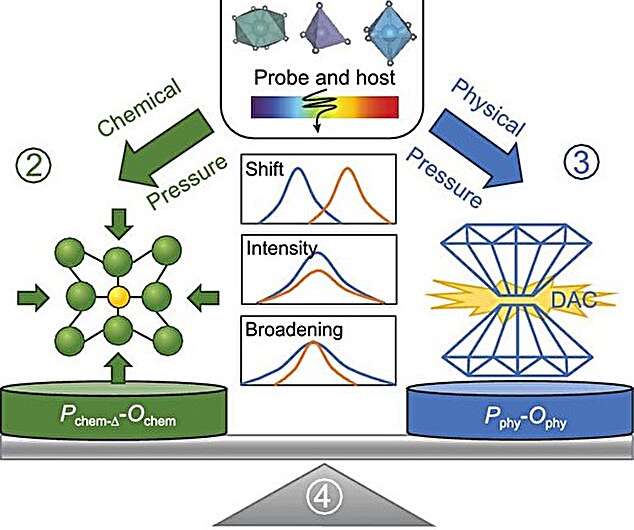This article has been reviewed according to Science X's editorial process and policies. Editors have highlighted the following attributes while ensuring the content's credibility:
fact-checked
trusted source
proofread
Local chemical pressure experimentally sensed by optical probe

The practical application of high-pressure metastable materials is hindered by severe synthesis condition, poor yield, and mostly vanishing phase and phenomena after decompressing. The scaled-up capture of these metastable states to ambient pressure is the key point but remains a challenge.
Chemical pressure, a passive interatomic force, has been widely adopted to mimic the effect of physical pressure. Generally, chemical pressure can be achieved by elemental substitution or epitaxial strain to induce cell contraction as observed under physical pressure.
A study, titled "Calibration of local chemical pressure by optical probe" and, led by Prof. Man-Rong Li (School of Chemistry, Sun Yat-sen University, and School of Science, Hainan University) and Prof. Xianran Xing (Institute of Solid State Chemistry, University of Science and Technology Beijing) has been published in National Science Review.
"We have successfully intercepted some metastable polar magnets in bulk-doping at ambient pressure, and generate equivalent pressure around 5–9 GPa. Interestingly, their physical properties got further enhanced by atomic-scale local structure modulation," Li says. Xing points out that, "the advantage of chemical pressure is that, it can be either positive or negative in contrast to the positive physical pressure, leaving a huge space for metastable phase exploration."
Li and Xing, together with their team members, sought to answer an open question: how far can the chemical pressure simulate the effect of physical pressure?
Although equivalent effect has been mimicked by chemical pressure in most cases, exception exists. In cuprate superconductors, researchers found out that, the unit cell volume (V) similarly keep contraction under physical and positive chemical pressures, however, the critical temperature (Tc) varies oppositely, dominated by the opposite of evolution of local Cu-O distance.
"Apparently, the conventional estimation of chemical pressure (based on V) is insufficient to intercept the desired function, we have to figure out a way to scale the chemical pressure passed to the local structure, namely local chemical pressure," Li says.
The function of solid-state matter is mostly governed by atomic-scale structural motifs, so it is critical to onsite sense the local chemical pressure. Calibration of the local chemical pressure is technically challenging.
Li, Xing, and coworkers innovatively propose a site-selective optical-probe approach to measure the chemical pressure exerted to polyhedral motif. Taking site-selective Bi3+ in REO8 of REVO4 (RE = Y, Gd) as an optical probe, the physical and local chemical pressures are connected via emission-peak shift, reflecting the pressure experienced by REO8 polyhedron. "Since the optical emission is mainly determined by the polyhedral (crystal field) evolution, it intuitively rates the local chemical pressure, and bridges it to physical pressure" Li says.
"The experimental calibration of local chemical pressure makes it possible to conduct function-oriented chemical stabilization of metastable phases. Our previous attempts based on the cell volume or lattice manipulation can simulate the geometric effect (volumetric contraction) of physical pressure, but cannot always guarantee the capturing of similar physical properties, because the chemical pressure transmitting can be highly anisotropic in very local-structure scale."
"That says, for a given compound, it is the evolution of pressure-induced local structure that dominates the functions in solids. These findings will guide our research in a more precise manner in the future," Xing says.
The optical-probe calibration of local chemical pressure in polyhedral scale develops a methodology to further understand the essence of chemical pressure.
Theoretically, the chemical pressure exerted to superfine local structure, such as chemical bond, atom, even electron, can also be sensed if there is any proper "probe" to track the evolution of corresponding "indicator" under physical and chemical pressures, such as the Raman spectrum, atomic force signal, band gap, and so on.
Hopefully, someday, the room-temperature superconductivity under high pressure can be realized in the future by chemical approaches. That is one of the key missions for solid state chemists.
More information: Xiao Zhou et al, Calibration of local chemical pressure by optical probe, National Science Review (2023). DOI: 10.1093/nsr/nwad190
Provided by Science China Press



















